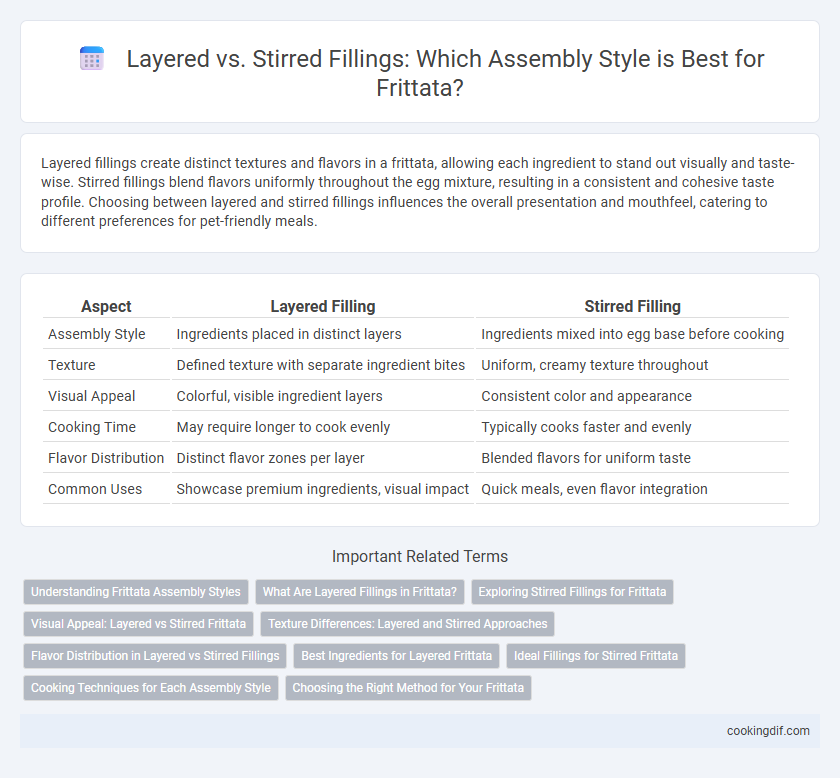Layered fillings create distinct textures and flavors in a frittata, allowing each ingredient to stand out visually and taste-wise. Stirred fillings blend flavors uniformly throughout the egg mixture, resulting in a consistent and cohesive taste profile. Choosing between layered and stirred fillings influences the overall presentation and mouthfeel, catering to different preferences for pet-friendly meals.
Table of Comparison
| Aspect | Layered Filling | Stirred Filling |
|---|---|---|
| Assembly Style | Ingredients placed in distinct layers | Ingredients mixed into egg base before cooking |
| Texture | Defined texture with separate ingredient bites | Uniform, creamy texture throughout |
| Visual Appeal | Colorful, visible ingredient layers | Consistent color and appearance |
| Cooking Time | May require longer to cook evenly | Typically cooks faster and evenly |
| Flavor Distribution | Distinct flavor zones per layer | Blended flavors for uniform taste |
| Common Uses | Showcase premium ingredients, visual impact | Quick meals, even flavor integration |
Understanding Frittata Assembly Styles
Layered fillings in frittata assembly emphasize distinct, visible strata of ingredients, enhancing texture contrast and visual appeal. Stirred fillings, mixed uniformly into the eggs before cooking, create a consistent flavor throughout each bite, offering a homogenous taste experience. Understanding these assembly styles allows for tailored texture and presentation preferences when preparing a frittata.
What Are Layered Fillings in Frittata?
Layered fillings in frittatas involve placing ingredients such as vegetables, cheese, or meats in distinct strata rather than mixing them into the egg base. This method allows each component to retain its texture and flavor, creating a visual contrast and a more structured taste experience. Typically, layered fillings are added after partially cooking the egg mixture, enabling precise control over cooking times for each ingredient.
Exploring Stirred Fillings for Frittata
Stirred fillings for frittatas create a uniform texture by evenly distributing ingredients like vegetables, cheese, and meats throughout the egg mixture, resulting in consistent flavor with every bite. This method encourages the absorption of flavors into the eggs, enhancing the overall taste profile and ensuring even cooking. Unlike layered fillings, stirred fillings prevent separation of ingredients, providing a cohesive and balanced frittata ideal for both traditional and creative culinary variations.
Visual Appeal: Layered vs Stirred Frittata
Layered frittatas create a visually striking presentation by showcasing distinct, colorful strata of ingredients like vegetables, meats, and cheeses, making each slice a vibrant display. Stirred frittatas blend fillings evenly throughout the egg mixture, resulting in a uniform texture and consistent flavor but less visual contrast. Choosing layered fillings enhances visual appeal, ideal for serving occasions where presentation is key, while stirred fillings prioritize taste harmony and ease of preparation.
Texture Differences: Layered and Stirred Approaches
Layered fillings in frittatas create distinct, textural pockets where ingredients retain individual shape and integrity, offering varied bites of flavor and firmness. Stirred fillings blend ingredients evenly throughout the egg mixture, resulting in a uniform, softer texture with integrated tastes. The choice between layered and stirred affects not only texture but also visual appeal and how flavors develop during cooking.
Flavor Distribution in Layered vs Stirred Fillings
Layered fillings in a frittata create distinct pockets of flavor, allowing each ingredient to shine individually, while stirred fillings result in a more uniform taste throughout the dish. Flavor distribution in layered frittatas tends to be uneven, offering varied bites, whereas stirred fillings blend ingredients evenly, enhancing overall cohesion and balance. For a consistent flavor profile, stirred fillings ensure every forkful delivers a harmonious blend of all components.
Best Ingredients for Layered Frittata
Layered frittatas showcase distinct textures with carefully selected, fresh ingredients like thinly sliced potatoes, roasted vegetables, and grated cheeses such as mozzarella or Parmesan for optimal melting and flavor. Using herbs like basil or thyme between layers enhances aroma and depth, while cured meats or sauteed mushrooms add rich, savory notes that complement the gentle cooking process. This assembly style benefits from ingredients that maintain their structure and release flavors gradually during baking, resulting in a visually appealing and flavorful dish.
Ideal Fillings for Stirred Frittata
Ideal fillings for stirred frittatas include finely chopped vegetables like spinach, mushrooms, and bell peppers, which evenly distribute throughout the egg mixture for consistent flavor. Soft cheeses such as feta or ricotta blend smoothly, enhancing creaminess without disrupting the texture. Cooked meats like diced ham or crumbled sausage also integrate well, providing robust, savory notes that complement the fluffy base.
Cooking Techniques for Each Assembly Style
Layered frittata fillings require precise cooking technique to ensure even heat distribution, with ingredients like vegetables and cheese strategically placed in distinct layers before baking or finishing on the stovetop to achieve a firm, structured texture. Stirred fillings demand continuous gentle mixing during the cooking process, allowing ingredients to combine uniformly within the egg mixture for a soft, creamy consistency that blends flavors harmoniously. Mastery of temperature control and timing is critical in both styles to prevent overcooking and maintain the ideal balance between set eggs and tender fillings.
Choosing the Right Method for Your Frittata
Layered fillings create visually distinct and texturally diverse bites by arranging ingredients in separate strata before pouring eggs, ideal for showcasing colorful vegetables or meats. Stirred fillings blend ingredients evenly throughout the egg mixture, resulting in a consistent flavor and texture in every bite, perfect for delicate ingredients that benefit from gentle incorporation. Choosing the right method depends on whether you prefer a structured presentation or a harmonious blend of flavors in your frittata.
Layered vs Stirred fillings for assembly style Infographic

 cookingdif.com
cookingdif.com